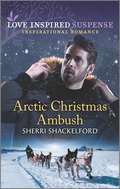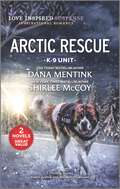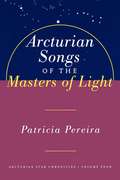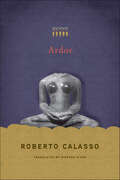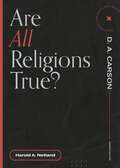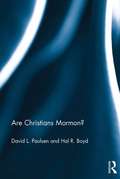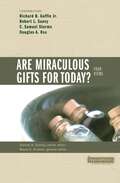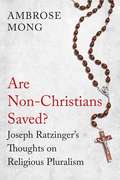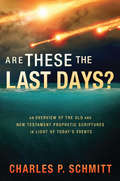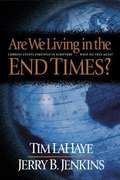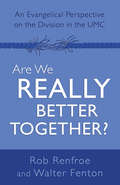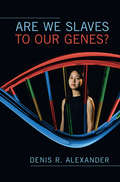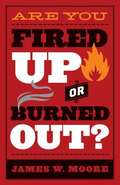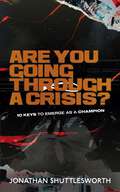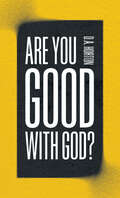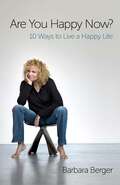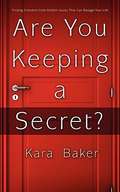- Table View
- List View
Archives of Conjure: Stories of the Dead in Afrolatinx Cultures (Gender, Theory, and Religion)
by Solimar OteroIn Afrolatinx religious practices such as Cuban Espiritismo, Puerto Rican Santería, and Brazilian Candomblé, the dead tell stories. Communicating with and through mediums’ bodies, they give advice, make requests, and propose future rituals, creating a living archive that is coproduced by the dead. In this book, Solimar Otero explores how Afrolatinx spirits guide collaborative spiritual-scholarly activist work through rituals and the creation of material culture. By examining spirit mediumship through a Caribbean cross-cultural poetics, she shows how divinities and ancestors serve as active agents in shaping the experiences of gender, sexuality, and race.Otero argues that what she calls archives of conjure are produced through residual transcriptions or reverberations of the stories of the dead whose archives are stitched, beaded, smoked, and washed into official and unofficial repositories. She investigates how sites like the ocean, rivers, and institutional archives create connected contexts for unlocking the spatial activation of residual transcriptions. Drawing on over ten years of archival research and fieldwork in Cuba, Otero centers the storytelling practices of Afrolatinx women and LGBTQ spiritual practitioners alongside Caribbean literature and performance. Archives of Conjure offers vital new perspectives on ephemerality, temporality, and material culture, unraveling undertheorized questions about how spirits shape communities of practice, ethnography, literature, and history and revealing the deeply connected nature of art, scholarship, and worship.
Arctic Christmas Ambush
by Sherri ShackelfordCaught between a killer on the looseand a deadly snowstorm…A man’s been murdered, and the only witness is Alaska State Trooper Shane Taylor’s ex, Kara Riley—a woman he’s sure has been keeping secrets. Now Shane and Kara are snowbound during a dangerous winter storm—with the killer! Shane’s convinced this has to be tied to Kara’s past, and he needs to find the truth…before they become a murderer’s next victims.From Harlequin Love Inspired Suspense: Courage. Danger. Faith.
Arctic Rescue
by Dana Mentink Shirlee McCoyDeadly Alaskan missionYukon Justice by Dana MentinkWhen her estranged uncle attempts to sabotage her family&’s reindeer ranch, K-9 team assistant Katie Kapowski heads home to help save it—and becomes his target. With their rocky past, Alaska State Trooper Brayden Ford and his furry partner are the last team Katie wants assigned to protect her. But with the ranch under siege, they must work together…or risk falling victim to a killer.Blizzard Showdown by Shirlee McCoyAfter months of searching for Violet James, Gabriel Runyon and his K-9 partner finally track her down—just in time to rescue her from her ex-fiancé. Now they must safeguard the single mother and her newborn daughter. Leaving Violet&’s Alaskan hideout is the safest option, but with a winter storm rolling in, it&’s not just a murderer they have to escape…USA TODAY Bestselling Author Dana MentinkNew York Times Bestselling Author Shirlee McCoy2 Thrilling Stories Yukon Justice and Blizzard Showdown
Arctic Witness (Alaska K-9 Unit #6)
by Heather WoodhavenA killer on the hunt… and a woman and a child to protect. When his ex-wife goes missing in the wilderness, Alaska State Trooper Sean West and his K-9 partner rescue her from a kidnapper. But survivalist expert Ivy West saw the face of a murderer and now she and her foster child are targets. Now Sean must protect them and confront what drove him and Ivy apart…or risk losing the family he never thought he wanted.From Love Inspired Suspense: Courage. Danger. Faith.Alaska K-9 Unit Book 1: Alaskan Rescue by Terri ReedBook 2: Wilderness Defender by Maggie K. BlackBook 3: Undercover Mission by Sharon DunnBook 4: Tracking Stolen Secrets by Laura ScottBook 5: Deadly Cargo by Jodie BaileyBook 6: Arctic Witness by Heather WoodhavenBook 7: Yukon Justice by Dana MentinkBook 8: Blizzard Showdown by Shirlee McCoy
Arcturian Songs Of The Masters Of Light: Arcturian Star Chronicles, Volume Four (The Arcturian Star Chronicles)
by Patricia PereiraIn 1987, medical transcriptionist Patricia Pereira suddenly started receiving telepathic communications from the star Arcturus and was requested to begin a series of galactically inspired manuscripts, Arcturian Songs of the Masters of Light is the fourth volume in the series. The mission of this series of books is to awaken us to our individual and collective spiritual obligation for the health and well being of our planet and all creatures who live upon her. Philosophical in cope, the essays in these books provide pragmatic, practical suggestions for emotional, mental physical, and spiritual transformation. They remind us of our familial relationships to beings of light who inhabit the great star nations. Arcturian Songs of the Masters of Light moves beyond solely Arcturian energies to incorporate high-level representatives of the brotherhoods of light, including Christ Essence and Sanat Kumara of the Order of Melchizedek.
Ardor
by Roberto CalassoIn a meditation on the wisdom of the Vedas, Roberto Calasso's Ardor brings ritual and sacrifice to bear on the modern worldIn this revelatory volume, Roberto Calasso, whom The Paris Review has called "a literary institution," explores the ancient texts known as the Vedas. Little is known about the Vedic people, who lived more than three thousand years ago in northern India: They left behind almost no objects, images, or ruins. They created no empires. Even the soma, the likely hallucinogenic plant that appears at the center of some of their rituals, has not been identified with any certainty. Only a "Parthenon of words" remains: verses and formulations suggesting a daring understanding of life."If the Vedic people had been asked why they did not build cities," writes Calasso, "they could have replied: we did not seek power, but rapture." This is the ardor of the Vedic world, a burning intensity that is always present, both in the mind and in the cosmos. With his signature erudition and profound sense of the past, Calasso explores the enigmatic web of ritual and myth that defines the Vedas. Often at odds with modern thought, these texts illuminate the nature of consciousness more vividly than anything else has managed to till now. Following the "hundred paths" of the Satapatha Brahmana, an impressive exegesis of Vedic ritual, Ardor indicates that it may be possible to reach what is closest by passing through that which is most remote, as "the whole of Vedic India was an attempt to think further."
Are All Religions True? (Questions for Restless Minds)
by Harold A. NetlandHow you should think about religious diversity. We live in a diverse world. Religious pluralism holds that each religion is of equal worth and offers a legitimate lifestyle. But Christianity claims Jesus is the only way to be saved. Is Christianity bigoted? In Are All Religions True?, Harold A. Netland offers a Christian response to religious pluralism. Netland considers the nature of religious claims, tolerance, and the great commission. Wisdom is needed. While Christians should support aspects of religious diversity, we also believe that Jesus is the Lord and Savior of all. Learn how you can be devoted to Christ while showing love for those of other faiths. The Questions for Restless Minds series applies God's word to today's issues. Each short book faces tough questions honestly and clearly, so you can think wisely, act with conviction, and become more like Christ.
Are Christians Mormon?: Joseph Smith And Converging Christian Theologies
by David L. Paulsen Hal R. BoydIn the past, scholars and others have asked whether Mormons are Christian. This work reverses the question by asking, "are Christians Mormon?" By identifying Mormon doctrines formerly considered heretical and documenting how these doctrines have gained increasing acceptance within mainstream Christian theologies, the work presents some surprising insights. In chapters focusing on subjects such as deification, the divine feminine, and the reopening of the scriptural canon, among others, the book sets out Joseph Smith's teachings on these ideas, summarizes the criticisms of those positions, and examines trends in contemporary Christian theology that significantly converge in Joseph's direction. Exploring the convergence of contemporary Christian theology with Mormon doctrines, this book will appeal to a broad range of students and readers exploring Christian theology and the Latter-day Saint tradition.
Are Miraculous Gifts for Today?: 4 Views (Counterpoints: Bible and Theology)
by Stanley N. Gundry Wayne A. GrudemAre the gifts of tongues, prophecy, and healing for today? No, say cessationists. Yes, say Pentecostal and Third Wave Christians. Maybe, say a large sector of open-but-cautious evangelicals. What’s the answer? Is there an answer? Are Miraculous Gifts for Today? takes you to the heart of the charismatic controversy. It provides an impartial format for comparing the four main lines of thinking: cessationist, open but cautious, third wave, and Pentecostal/charismatic. The authors present their positions in an interactive setting that allows for critique, clarification, and defense. This thought-provoking book will help Christians on every side of the miraculous gifts debate to better understand their own position and the positions of others. Wayne Grudem has brought online the four major views on miraculous gifts today. Downloading them into your own understanding takes effort, but the worldwide network that you join is the fellowship of the Spirit! The Counterpoints series provides a forum for comparison and critique of different views on issues important to Christians. Counterpoints books address two categories: Church Life and Bible and Theology. Complete your library with other books in the Counterpoints series.
Are Non-Christians Saved?: Joseph Ratzinger's Thoughts on Religious Pluralism
by Ambrose MongReligious pluralism is thriving and becoming vitally important. This is not only the case in Asia with its myriad religious beliefs and practices, but also in Europe, which has seen the growth and development of many non-Christian religious traditions which compete with its Christian heritage. Joseph Ratzinger, former Prefect of the Congregation for the Doctrine of the Faith and now Pope-Emeritus Benedict XVI, is commonly regarded as a conservative theologian who sees religious pluralism as a challenge to the church's ability to proclaim the gospel with greater fidelity. This means that in the face of multiple religious beliefs, Christians must be convinced of the truth of their faith.The author examine Ratzinger's thoughts on this issue of religious pluralism, in order to evaluate how the official church has responded to the call of Vatican II to create a dialogue with non-Christian faiths. This book, thus, attempts to understand what the 'guardian of the faith' says and why he says it. It does this by looking at Ratzinger's educational, cultural and religious background to reveal his Eurocentric bias, particularly in his ecclesiology, ecumenical theology, and attitude towards religious pluralism with its 'evil twins' of relativism and secularism.
Are These the Last Days?
by Charles Schmitt“The path of the righteous is like the first gleam of dawn, shining ever brighter till the full light of day.” —Proverbs 4:18, NKJV Solomon says in Proverbs 4:18 that we can expect an increase in enlightenment and an expansion of understanding as we approach the last days. That is Charles P. Schmitt’s position as he presents a fresh scrutiny of Old and New Testament prophetic scriptures in the light of today's world events. He traces not only the conflict between Israel and the Arab world but also their amazing last-days promises of restoration. At all times he underscores the primary backdrop for any Christian view of the last days: worldwide evangelism before the end comes. Are These the Last Days? will graciously challenge your status quo understanding of end-time prophecies and enable you, as Solomon said, to see this subject in an “ever brighter” light.
Are We Living In The End Times?
by Tim Lahaye Jerry B. JenkinsAn explanation of things that must be fulfilled before the second coming of Christ and a look into end time profacy.
Are We Really Better Together? Revised Edition: An Evangelical Perspective on the Division in The UMC
by Rob Renfroe Walter FentonThe authors set out to address the division within The United Methodist Church and contend that remaining united is hurting the church and the proclamation of the gospel. Recognizing that conservative and progressive Methodists are sincere in their beliefs, the authors doubt that one side will convince the other to change their minds. They therefore suggest that a fair and amicable separation is the best course of action. "The United Methodist Church is at a crossroads. We are a divided church and the truth is we are a hurting church.Some of us believe that our differences are so great and the ongoing battle so destructive that it’s time to part ways. For over four decades conservative and progressive United Methodists have expended enormous emotional, financial and spiritual resources to gain the upper hand in a denomination that has declined every year since its founding in 1968. Surely our efforts and our finances would be better devoted to evangelism, discipleship and missions. For the sake of the lost and the poor, shouldn’t we set each other free to pursue what we believe to be God’s calling upon our lives and our ministries?" (From the Introduction)
Are We Really Better Together?: An Evangelical Perspective on the Division in The UMC
by Rob Renfroe Walter FentonThe authors set out to address the division within The United Methodist Church and contend that remaining united is hurting the church and the proclamation of the gospel. Recognizing that conservative and progressive Methodists are sincere in their beliefs, the authors doubt that one side will convince the other to change their minds. They therefore suggest that a fair and amicable separation is the best course of action. "The United Methodist Church is at a crossroads. We are a divided church and the truth is we are a hurting church. Some of us believe that our differences are so great and the ongoing battle so destructive that it’s time to part ways. For over four decades conservative and progressive United Methodists have expended enormous emotional, financial and spiritual resources to gain the upper hand in a denomination that has declined every year since its founding in 1968. Surely our efforts and our finances would be better devoted to evangelism, discipleship and missions. For the sake of the lost and the poor, shouldn’t we set each other free to pursue what we believe to be God’s calling upon our lives and our ministries?" (From the Introduction)
Are We Slaves to our Genes?
by Denis R. AlexanderThere is a common misconception that our genomes - all unique, except for those in identical twins - have the upper hand in controlling our destiny. The latest genetic discoveries, however, do not support that view. Although genetic variation does influence differences in various human behaviours to a greater or lesser degree, most of the time this does not undermine our genuine free will. Genetic determinism comes into play only in various medical conditions, notably some psychiatric syndromes. Denis Alexander here demonstrates that we are not slaves to our genes. He shows how a predisposition to behave in certain ways is influenced at a molecular level by particular genes. Yet a far greater influence on our behaviours is our world-views that lie beyond science - and that have an impact on how we think the latest genetic discoveries should, or should not, be applied. Written in an engaging style, Alexander's book offers tools for understanding and assessing the latest genetic discoveries critically.
Are We There Yet?: My Journey from a Messed-Up to Meaningful Life
by Jeff AllenComedic and Inspirational memoir from the stand-up comic who coined the phrase &“Happy Wife, Happy Life&”.
Are You Fired Up or Burned Out?
by James W. MooreHave you ever felt a little bored, tired, or stressed about your lifeand even your faith? Haven’t we all? This "world weariness" can happento anyone. Yet Jesus came that we might have exciting, joyful, abundantlife! The question is… how?In Are You Fired Up or Burned Out?best-selling author James W. Moore explains how to move from fatigue tofavor. In short, encouraging, and practical chapters, you will learnhow to Recognize-Remember-Relax: Recognize your fatigue limit Remember your priorities Relax your soul in GodToday's busy world may bring a tiredness that cansettle on the human spirit. Struggling through hectic, frenzied,stressful lives, we scrape and scramble toward something that leavesus...empty...and feeling cheated, let down, and bone weary. God doesn’twant it to be that way for us. Find out how, with His help, you can stay excited,exhilarated, fulfilled, and truly fired up about life.
Are You Going Through a Crisis?: 10 Keys to Emerge as a Champion
by Jonathan ShuttlesworthThose who trust in the Lord are as secure as Mount Zion; they will not be defeated but will endure forever. ~Psalm 125:1 (NLT)The Devil will convince you that victory is impossible, your situation is irreparable, you’ll always be a victim, and you'll struggle with your problem for the remainder of your life—secular counseling will teach you the same.You are what the Bible says you are; you’re a champion, and you can walk in victory regardless of circumstance. The Bible says, “they will not be defeated.” You have a scriptural right to be victorious…it's time to discover and claim what belongs to you.In this concise, authoritative book, Evangelist and Pastor Jonathan Shuttlesworth offers ten keys from the Bible for unlocking victory and emerging from crisis as a champion, not a victim.You’ll learn what belongs to you, the dangers of isolation, the value of fasting and prayer, the power of joy, when to keep your mouth closed, why the Devil fails, how to outthink your adversary, how to gain strength from faith, and why you can refuse to worry.If you’re going through a crisis, don't let it destroy your mind, family, and household. Life can be good—you can be a champion!About the Author:Pastor, teacher, and evangelist Jonathan Shuttlesworth is the founder of Revival Today, a ministry dedicated to reaching lost and hurting people with the Gospel of Jesus Christ. He pastors Revival Today Church, located in Pittsburgh, Pennsylvania.
Are You Gonna Kiss Me or Not?
by Travis Thrasher Thompson SquareA novel about the long, winding journey to love for a pair of struggling songwriters, based on the hit song "Are You Gonna Kiss Me or Not?", from platinum-selling country music duo Thompson Square. Daniel and Casey were an unlikely couple back in high school, when they came together to write the music for a school function. Struggling against their differences, they dated during college, but their relationship never seemed quite right. Yet despite their personal conflict, as songwriters they had undeniable chemistry--and two hit songs. Eventually they went their own ways, both trying to make it in the music world and find true love. Years later, both Daniel and Casey are at rock bottom, dealing with divorce and still trying to find success. But when they connect again as old friends, they realize that what they needed was right in front of them all along: each other. From Thompson Square, a married twosome who know a little something about what it's like to overcome the years of struggle in the music business while finding love and happiness, Are You Gonna Kiss Me or Not? is a charming and humorous love story about coming of age, knowing where you belong, and finding the perfect person to share life with.
Are You Gonna Kiss Me or Not?: A Novel
by Travis Thrasher Thompson SquareDaniel and Casey were an unlikely couple back in high school when they came together to write music for a school event. Struggling against their differences, they dated during college, but their relationship never seemed quite right. Yet despite their personal conflict, as songwriters they had undeniable chemistry—and several hit songs. Eventually they went their own ways, both trying to make it in the music world and find true love.
Are You Good with God?
by D.A. HortonThe gospel according to hip hop. Yeah, that&’s a thing.Christian ideas often show up in hip hop music. Biblical themes and even Jesus Himself appear in the lyrics. But beneath all the God-talk, can a true gospel message be found?Pastor D. A. Horton (aka hip hop artist Azriel) says yes. And he wants you to know the gospel message is deep . . . powerful . . . theological . . . and surprisingly simple to comprehend. It all comes down to:God&’s designOur downfallGod&’s demonstrationOur decisionAre You Good With God? is a book of giant truths written in the raw and rhythmic style of hip hop. The poetry of the streets will energize you with the dynamic power of Scripture. Like every other global language, hip hop speaks to the human heart with truths that really matter. So if hip hop is your mother tongue, why not listen to what God is saying to you?
Are You Good with God?
by D.A. HortonThe gospel according to hip hop. Yeah, that&’s a thing.Christian ideas often show up in hip hop music. Biblical themes and even Jesus Himself appear in the lyrics. But beneath all the God-talk, can a true gospel message be found?Pastor D. A. Horton (aka hip hop artist Azriel) says yes. And he wants you to know the gospel message is deep . . . powerful . . . theological . . . and surprisingly simple to comprehend. It all comes down to:God&’s designOur downfallGod&’s demonstrationOur decisionAre You Good With God? is a book of giant truths written in the raw and rhythmic style of hip hop. The poetry of the streets will energize you with the dynamic power of Scripture. Like every other global language, hip hop speaks to the human heart with truths that really matter. So if hip hop is your mother tongue, why not listen to what God is saying to you?
Are You Happy Now?: 10 Ways to Live a Happy Life
by Barbara BergerWhat is preventing you from being happy now? Is it your partner, your health, your job, your financial situation or your weight? Or is it all the things you think you "should" do? Barbara Berger takes a look at all the things we think and do that prevent us from living happy lives now. The book's basic premise is that our thoughts determine our experience of reality--and understanding this is the key to living a happy life. This is a revolutionary way of looking at life because most people believe that outer conditions are the reason why they are unhappy. But if outer conditions are not the cause--what is? Berger presents 10 practical ways to use this understanding in your daily life, your relationships, at work and for your health. And she gives examples from her own dramatic life since leaving America at the young age of 18 in protest against the Vietnam War and settling in Scandinavia to her lifelong exploration of the power of mind and the nature of consciousness.
Are You Keeping A Secret?: Finding Freedom From Hidden Issues That Can Ravage Your Life
by Kara BakerAre You Keeping a Secret? Secrets. Every woman has at least one. Which ones should you tell? Keeping a confidence private is fine when it's for the good of someone else. But secrets kept hidden inside us for the purpose of avoiding pain can cause harm. Whether we hide something we've done or something others have done to us, our secrets cut us off from life. This book reveals the truth about the secrets we bury deep in our heart. Every day they affect our attitudes, actions, reactions, and decisions. Holding onto secrets wears us down emotionally, mentally, and physically. But there is hope. Secrets exposed to the truth lose their power to control us. You can experience healing in your life! Are You Keeping a Secret? will help you identify your secrets, understand their impact, and take the steps necessary to start living fully and freely in the light of God's love. As you move from bondage to freedom, you will discover you can connect more intimately with others and with God. Are You Keeping a Secret? is a must-have for any woman who seeks liberty for her soul.
Are You Praying for the Wrong Thing?: Learning to Ask What God Wants for You, Not Just What You Want
by Travis GreeneThe Bible tells us to pray continually and without ceasing, but what happens when we're waiting for God but discover He's waiting for us? In his first book, pastor and recording artist Travis Greene guides the reader to apply Biblical truths for a fulfilled life.Praying and waiting for God to answer can be confusing. When something--or everything--feels stuck because God doesn't seem to be answering our prayers, what next? Pastor and Grammy–nominated recording artist Travis Greene issues a challenge and asks us to examine our prayers--Are we praying for the right thing? Are we planning and preparing for what we've asked for? Are we praying for our will to grow closer to His? Or do we sometimes treat him like a genie in a bottle? Using Biblical examples, Travis invites readers to reconsider our prayers andnavigate beyond feeling trapped to thriving in God&’s purposes;learn to use what's left instead of focusing on what was lost;be willing to forgive, wait, and work as God allows; andbelieve in God's miracles while being a faithful steward of what He has already provided.Sometimes what happens next depends on the choices made right now. And sometimes God has something else in mind for us--something we might never have imagined, or in a way we might not have imagined it! It's possible to press forward into a life filled with joy and expectation for the future! Like the widow who used the oil she had at hand, by using what God has already supplied, Travis encourages the readers that they may be closer to enjoying God's promises than they realize. Management can be a magnet for miracles.

